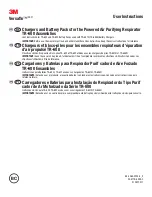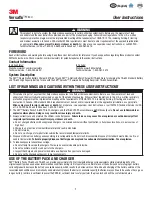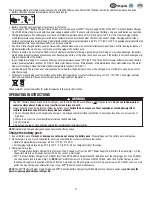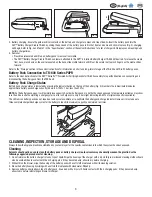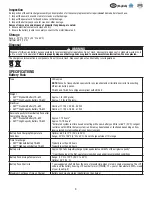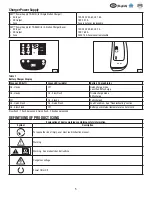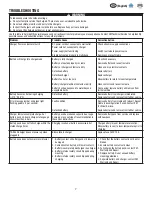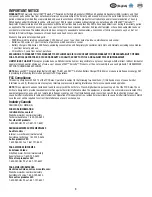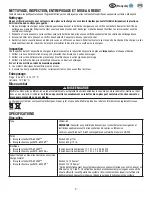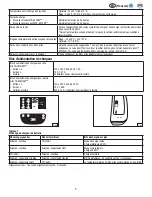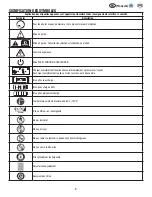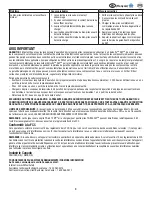
(English)
1
Versaflo
™
/MC
3
User Instructions
W
WARNING
This product is part of a system that helps reduce exposures to certain airborne contaminants. Before use, the wearer must read
and understand the
User Instructions
provided as a part of the product packaging. Follow all local regulations. In the U.S., a written
respiratory protection program must be implemented meeting all the requirements of OSHA 1910.134, including training, fit testing
and medical evaluation. In Canada, CSA standard Z94.4 requirements must be met and/or requirements of the applicable jurisdiction,
as appropriate.
Misuse may result in injury, sickness or death.
For proper use, see supervisor,
User Instructions,
or call 3M PSD
Technical Service in USA at 1-800-243-4630 and in Canada at 1-800-267-4414.
FOREWORD
Read all instructions and warnings before using. Keep these
User Instructions
for reference. If you have questions regarding these products contact
3M Technical Service. Check www.3m.com/workersafety for potential updates to these
User Instructions
.
Contact Information
In United States:
Website: www.3m.com/workersafety
Technical Service: 1-800-243-4630
In Canada:
Website: www.3M.ca/Safety
Technical Service: 1-800-267-4414
System Description
The 3M™ Single Station Battery Charger Kit TR-641N and 3M™ 4-Station Battery Charger Kit TR-644N are for charging the TR-630 Standard Battery
and TR-632 High Capacity Battery for use with the 3M™ Versaflo™ Powered Air Purifying Respirator TR-600 Assemblies.
LIST OF WARNINGS AND CAUTIONS WITHIN THESE
USER INSTRUCTIONS
W
WARNING
1. This product is part of a system that helps reduce exposures to certain airborne contaminants. Before use, the wearer must read and
understand the
User Instructions
provided as a part of the product packaging. Follow all local regulations. In the U.S., a written respiratory
protection program must be implemented meeting all the requirements of OSHA 1910.134, including training, fit testing and medical
evaluation. In Canada, CSA standard Z94.4 requirements must be met and/or requirements of the applicable jurisdiction, as appropriate.
Misuse may result in injury, sickness or death.
For proper use, see supervisor,
User Instructions
, or call 3M PSD Technical Service in USA
at 1-800-243-4630 and in Canada at 1-800-267-4414.
2. The 3M™ Battery Packs TR-630, TR-632, chargers, and the TR-600 PAPR assemblies are
not
intrinsically safe.
Do not use in flammable or
explosive atmospheres. Doing so may result in serious injury or death.
3. Always correctly use and maintain the Lithium-ion battery packs.
Failure to do so may cause fire or explosion or could adversely affect
respirator performance and result in injury, sickness or death.
a. Do not charge batteries with unapproved chargers, in enclosed cabinets without ventilation, in hazardous locations, or near sources of
high heat.
b. Charge in an area free of combustible material and readily monitored.
c. Do not immerse.
d. Do not use, charge, or store batteries outside the recommended temperature limits.
4. Dispose of Lithium-ion battery packs according to local regulations. Do not crush, disassemble, dispose of in standard waste bins, in a fire, or
send for incineration.
Failure to properly dispose of battery packs may lead to environmental contamination, fire or explosion.
5. To reduce exposure to hazardous voltage:
a. Do not attempt to service the chargers. There are no user-serviceable parts inside.
b. Do not substitute, modify or add parts to the chargers.
c. Inspect the chargers and power cords before use. Replace if any parts are damaged.
d. Do not use the chargers outdoors or in wet environments.
USE OF THE BATTERY PACK AND CHARGER
3M™ Battery Packs TR-630 and TR-632 can provide approximately 250 full charge/discharge cycle equivalents while maintaining 80% of its
original capacity, when used under recommended conditions during its first year of service. Normal use of the battery and natural aging of battery
cells will gradually decrease the battery’s available capacity, which results in a decrease in run time. Use and charging of the battery outside of the
recommended conditions can dramatically and permanently reduce the battery’s available capacity. Batteries may continue to be used as they age, as
long as battery run time is sufficient to power the PAPR for sufficient time to safely perform the given task and exit the contaminated area.

